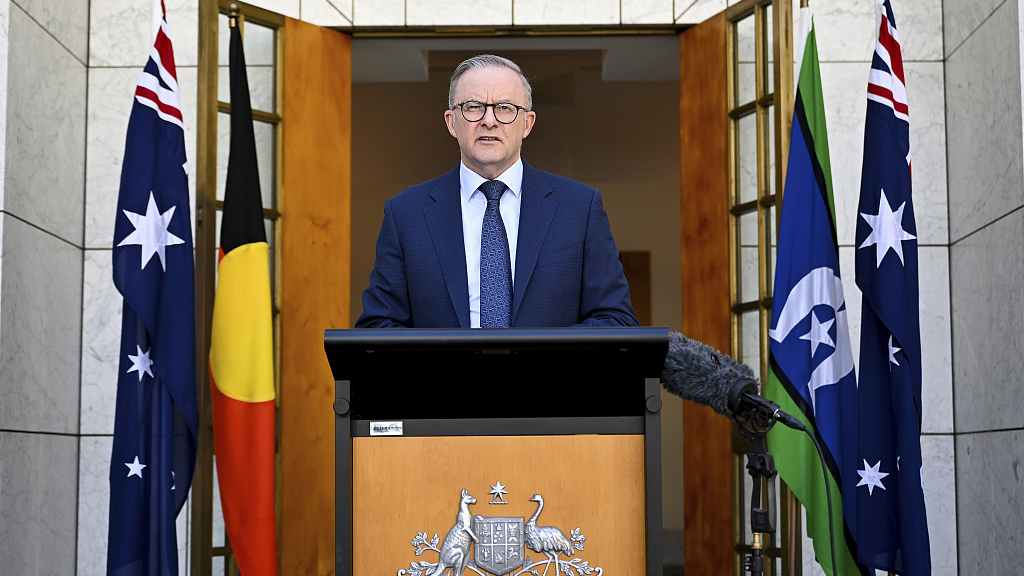
Australian Prime Minister Anthony Albanese speaks to the media during a press conference at Parliament House in Canberra, Australia, October 22, 2023. /CFP
Australian Prime Minister Anthony Albanese speaks to the media during a press conference at Parliament House in Canberra, Australia, October 22, 2023. /CFP
Editor's note: Daryl Guppy, a special commentator for CGTN, is an international financial technical analysis expert, who has provided weekly Shanghai Index analysis for mainland Chinese media for more than a decade. Guppy appears regularly on CNBC Asia and is known as "the Chart Man." He is a former national board member of the Australia China Business Council. The article reflects the author's opinions and not necessarily the views of CGTN.
Australian Prime Minister Anthony Albanese is taking up the U.S. president's invitation for an official visit, extended after Joe Biden's last-minute cancellation of his planned trip to Australia in May.
In the 1970s, Australia's standard small arms weapon was the Belgian designed L1A1. The Bren gun designed by the British during World War II was still in use and troops were equipped with the American M113 armored personnel carrier. Although all of foreign manufacture, they posed no real threat to Australian's sovereign ability to make defense decisions because none of this equipment required specialized knowledge that resided only in the country of manufacture. Australia's sovereignty could not be quickly held at ransom by denying supply of this equipment.
Australia's sovereignty has been steadily eroded since 1970. Former Australian Prime Minister Malcom Fraser succinctly described the alliance with the U.S. in his 2016 book titled "Dangerous Allies" because of the way they undermined Australia's ability to make independent foreign policy decisions. Now some observers are suggesting that "Sovereignty has been cravenly sacrificed on the altar of the U.S.-Australian military alliance."
The sophistication of defense material has moved a long way in half a century and the issue of supply chain dependency, and along with it, the ability to make sovereign decisions, has changed dramatically. Now integrated weapons systems impinge directly on Australia's sovereign ability to forge and implement military decisions, which impacts foreign policy.
However, Australia rarely made the choice not to be involved in American military adventurism, following them into the Middle East and Afghanistan. Prime Minister John Howard (1996-2007) and his successors steadily promoted a mythology of Australian-American military mateship extending back to World War I. The boundaries of sovereign decision making were not really stretched because of Australia's willing compliance with U.S. strategic objectives.
The current Australian Defense Minister Richard Marles has moved the idea of defense cooperation further, now speaking of integrating Australian forces with U.S. military operations at a tactical and equipment level. This includes providing bases for B-52 bombers and the establishment of military supply dumps.
This represents the most significant change in the U.S.-Australian defense relationship because for all practical purposes, it effectively places Australian troops under the command of U.S. commanders who decide the strategic priorities. The reality is that Australia may never be in a position to deny U.S. access to bases and supplies if the U.S. decides to attack targets in the region. Some suggest this increases the United States military control over Australia.

A missile is launched from a United States military HIMARS system during joint military drills at a firing range in northern Australia as part of Exercise Talisman Sabre, the largest combined training activity between the Australian Defense Force and the United States military, in Shoalwater Bay, Queensland, Australia, July 22, 2023. /CFP
A missile is launched from a United States military HIMARS system during joint military drills at a firing range in northern Australia as part of Exercise Talisman Sabre, the largest combined training activity between the Australian Defense Force and the United States military, in Shoalwater Bay, Queensland, Australia, July 22, 2023. /CFP
However, it is the increased sophistication of weapons systems that poses a significant threat to the sovereignty of Australian decision making. The operational efficiency of the weapons systems critically relies on operational codes controlled by the United States. Withholding of software permissions or updates has the potential to immediately subvert and shape Australian responses to international events. As has happened previously, denying full access to the intelligence information flow coming from the U.S. defense force installation at Pine Gap inevitably shapes Australian foreign policy and defense responses.
It is a vulnerability already on display with the Australian Prime Minister Anthony Albanese's current visit to America. Prime Minister Albanese is trying try to kick-start AUKUS-related legislation which has stalled because of congressional dysfunction. He and Australian Ambassador to the U.S. Kevin Rudd are lobbying key lawmakers to pass several bills including one authorizing the sale of Virginia-class submarines to the Australian Navy. More important are the associated bills which authorize the sharing of the "classified" information and software necessary to actually make the submarines operational.
It is unclear what concessions or guarantees Australia will be required to make to ensure passage of this enabling legislation. This may include commitments to support U.S. strategic objectives that may not necessarily be in Australia's interest or which hamper Australia's ability to make independent sovereign decisions about foreign policy.
The increasing level of integration brings an increasing level of reliance and this is a growing threat to Australian sovereignty. Military cooperation always carries a small risk to sovereign independence. Australia's path to military integration with the United States poses a far greater risk because it goes well beyond defense cooperation by morphing into operational reliance.
(If you want to contribute and have specific expertise, please contact us at opinions@cgtn.com. Follow @thouse_opinions on Twitter to discover the latest commentaries in the CGTN Opinion Section.)